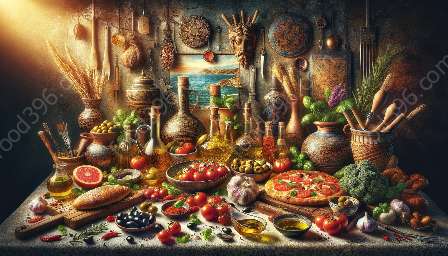The Byzantine Empire, with its rich and diverse cultural heritage, has left an indelible mark on the history of Mediterranean cuisine. Byzantine cuisine is a fascinating fusion of ancient Greek, Roman, and Middle Eastern culinary traditions, shaped over centuries of trade, conquest, and cultural exchange. The resulting culinary tapestry is an exploration of flavors, ingredients, and techniques that have had a lasting impact on modern Mediterranean cuisine and beyond.
The Historical Context
The Byzantine Empire, also known as the Eastern Roman Empire, was a hub of cultural and culinary exchange. Its strategic location at the crossroads of Europe, Asia, and Africa facilitated the flow of goods, spices, and cooking techniques, leading to a melting pot of gastronomic influences. The cuisine of Byzantium reflected the empire's vast territorial expanse and the diverse communities that inhabited it, resulting in a rich and varied culinary tradition.
Ingredients and Flavors
Byzantine cuisine embraced a wide array of ingredients, including grains, legumes, fruits, vegetables, meats, and seafood. Olive oil, a staple of Mediterranean cooking, featured prominently in Byzantine dishes, contributing to the distinctive flavor profile of the cuisine. Herbs and spices such as cumin, coriander, cinnamon, and saffron added depth and complexity to Byzantine recipes, creating a sensory tapestry of aromas and flavors.
The empire's diverse geography influenced the availability of ingredients, from the fertile lands of Anatolia to the bountiful seas of the Eastern Mediterranean. Byzantine cooks made ample use of locally sourced produce, incorporating regional specialties into their culinary creations.
Culinary Techniques and Traditions
Byzantine culinary traditions were a product of both innovation and tradition. The empire's skilled cooks developed sophisticated techniques for preserving foods, such as pickling, fermenting, and curing, allowing them to extend the shelf life of perishable ingredients. These preservation methods not only sustained the populace during times of scarcity but also contributed to the development of distinctive flavors and textures in Byzantine cuisine.
Bread held a central place in Byzantine meals, and the empire boasted a wide variety of breads, from simple flatbreads to elaborate loaves adorned with nuts, honey, and spices. The Byzantines also had a predilection for sweets, creating an assortment of decadent pastries, candied fruits, and honeyed desserts that delighted the palate.
Legacy and Influence
Byzantine cuisine's enduring legacy is evident in the widespread influence it has had on the gastronomic traditions of the Mediterranean and beyond. Its culinary techniques, flavor combinations, and ingredient pairings continue to resonate in modern-day cooking, enriching the global culinary landscape with a taste of history.
Exploring the world of Byzantine cuisine offers a window into the past, allowing us to savor the flavors and aromas that defined an empire and continue to captivate the senses today.

